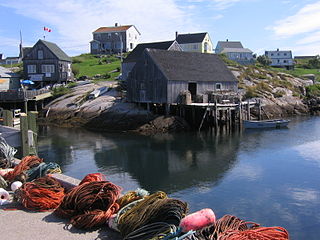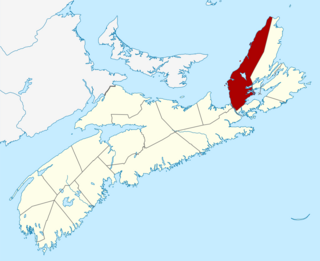Port Morien (also referred to as "Morien") is a small fishing community of 700 people in the Canadian province of Nova Scotia, located in the southeastern Cape Breton Island near the rural community Donkin, and six miles from the town of Glace Bay.
Port Morien (also referred to as "Morien") is a small fishing community of 700 people in the Canadian province of Nova Scotia, located in the southeastern Cape Breton Island near the rural community Donkin, and six miles from the town of Glace Bay.
Port Morien was first recorded as "Baie de Mordienne" on a map in 1580. In the nineteenth century, it was renamed Cow Bay by settlers. A cow allegedly escaped from a vessel when being transported from Sydney to Louisbourg and was found in the area. In 1895, its name was changed to Port Morien. [1]
The history of Port Morien can be traced back to the early 18th century, when the area was first settled by French and Scottish immigrants. The town quickly developed into a thriving fishing and mining community, with a bustling port and a thriving economy.
In the late 20th century, Port Morien faced a number of economic challenges, as the fishing and mining industries declined and many residents left the area in search of work. However, the community has remained resilient and has worked to diversify its economy and attract new businesses and residents.
The presence of coal in Cape Breton was first noted by Intendant Jean Talon in 1671. [1] It was the Treaty of Utrecht in 1713, and the subsequent founding of Louisbourg, which really focused French attention on Cape Breton coal as a valuable and necessary resource. The Fortress of Louisbourg and its inhabitants were in need of a local coal supply, and the closest source was the outcrop at Port Morien [1] So, the first commercial coal mine in North America began production at Port Morien in 1720. By 1724, coal from Port Morien was being traded to Boston in the first officially recorded export of minerals in Canada. The ownership of the mine, called the Gowrie Mines, changed hands between the English and French four times, with the English ultimately gaining control in the late eighteenth century. [1] In 1725, a blockhouse was built by the French to protect the valuable coal reserves.
Alongside the mining industry, the fishing industry also grew. Over time, the village has become dependent on lobster fishing as its main resource. In 2000, the lobster fleet consisted of 47 boats. [1] There has been a fish-processing plant operating at the harbour continuously by one family since 1941. There is also a boatbuilding business in town.
There are many active organizations and clubs in the Port Morien community. They include: a Royal Canadian Legion branch, a development association, a volunteer fire department, Girl Guides of Canada, a camera club, a community fair committee, a women's institute, an acting group, a wildlife association, a youth sports league, and a walking club. [2] There are also three churches: St John's United Church, St. Mary's Roman Catholic Church, and St. Paul's Anglican Church.
Although there is currently no active group, Port Morien was the site of the first Boy Scout troop in North America, founded in 1908 by William Glover, the chief book keeper of the North Atlantic Colliery. [3]

Cape Breton Island is an island on the Atlantic coast of North America and part of the province of Nova Scotia, Canada.

The Maritimes, also called the Maritime provinces, is a region of Eastern Canada consisting of three provinces: New Brunswick, Nova Scotia, and Prince Edward Island. The Maritimes had a population of 1,899,324 in 2021, which makes up 5.1% of Canada's population. Together with Canada's easternmost province, Newfoundland and Labrador, the Maritime provinces make up the region of Atlantic Canada.

Port Hood is an unincorporated place in the Municipality of the County of Inverness, Nova Scotia, Canada. It is an administrative centre and a service centre for the surrounding area. It is also the site of a registered historic place, Peter Smyth House.

Louisbourg is an unincorporated community and former town in Cape Breton Regional Municipality, Nova Scotia.

Cape Breton Regional Municipality is the Canadian province of Nova Scotia's second largest municipality and the economic heart of Cape Breton Island. As of 2016 the municipality has a population of 94,285. The municipality was created in 1995 through the amalgamation of eight municipalities located in Cape Breton County.
Glace Bay is a community in the eastern part of the Cape Breton Regional Municipality in Nova Scotia, Canada. It forms part of the general area referred to as Industrial Cape Breton.
Cape Breton South was a federal electoral district in the province of Nova Scotia, Canada, that was represented in the House of Commons of Canada from 1904 to 1911 and from 1925 to 1968.

The Sydney and Louisburg Railway (S&L) was a Canadian railway. Built to transport coal from various mines to the ports of Sydney and Louisbourg, the S&L operated in the eastern part of Cape Breton County, Nova Scotia. The railway uses a slightly different spelling for the town of "Louisbourg".

The Marconi National Historic Site and the Marconi Wireless Station National Historic Site are two National Historic Sites located on Cape Breton Island, Nova Scotia. Both sites commemorate the efforts of Guglielmo Marconi to transmit transatlantic radio signals between North America and Europe in the first decade of the 20th century. The two sites are located within approximately 8 kilometres (5.0 mi) of one another, and are connected by the Marconi Trail.
New Waterford is an urban community in the Cape Breton Regional Municipality of Nova Scotia, Canada.

Davis Day, also known as Miners' Memorial Day is an annual day of remembrance observed on June 11 in coal mining communities in Nova Scotia, Canada to recognize all miners killed in the province's coal mines.
Industrial Cape Breton is a geographic region in the Canadian province of Nova Scotia. It refers to the eastern portion of Cape Breton County fronting the Atlantic Ocean on the southeastern part of Cape Breton Island.
Mabou is an unincorporated settlement in the Municipality of the County of Inverness on the west coast of Cape Breton Island, Nova Scotia, Canada. The population in 2011 was 1,207 residents. It is the site of The Red Shoe pub, the An Drochaid Museum, and Glenora Distillers

Dominion is an unincorporated community in Nova Scotia's Cape Breton Regional Municipality. It is located immediately west of the larger centre of Glace Bay.
The Marconi Trail is a scenic roadway in the Canadian province of Nova Scotia.
Route 255 is a collector road in the Canadian province of Nova Scotia.

Broughton was a former town in the Cape Breton Regional Municipality about 19 kilometers from the city of Sydney, Nova Scotia. It was going to be one of Canada's first planned towns, designed to eventually accommodate 10,000 residents. In reality, it was mostly abandoned when mining operations failed.

Nova Scotia is a province located in Eastern Canada fronting the Atlantic Ocean. One of the Maritime Provinces, Nova Scotia's geography is complex, despite its relatively small size in comparison to other Canadian provinces.
Donkin is a Canadian rural village with a population of 532 as of 2021. Located on the picturesque coastline of Nova Scotia's Cape Breton Island, it is a part of the Cape Breton Regional Municipality. The smaller communities of Port Caledonia and Schooner Pond are directly adjacent to the village proper, connected by a single strip of road called the Donkin Highway.

The Municipality of the County of Inverness is a county municipality on Cape Breton Island, Nova Scotia, Canada. It provides local government to about 17,000 residents of the historical county of the same name, except for the incorporated town of Port Hawkesbury and the Whycocomagh 2 Miꞌkmaq reserve, both of which are enclaves. Public services are provided in the areas of recreation, tourism, administration, finance, and public works.